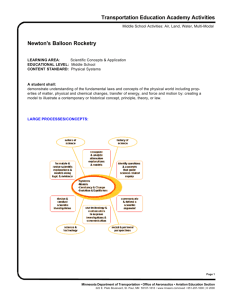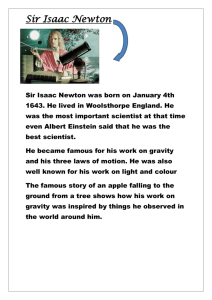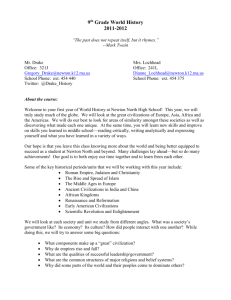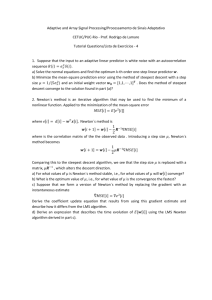Newton 3 laws of motion
advertisement
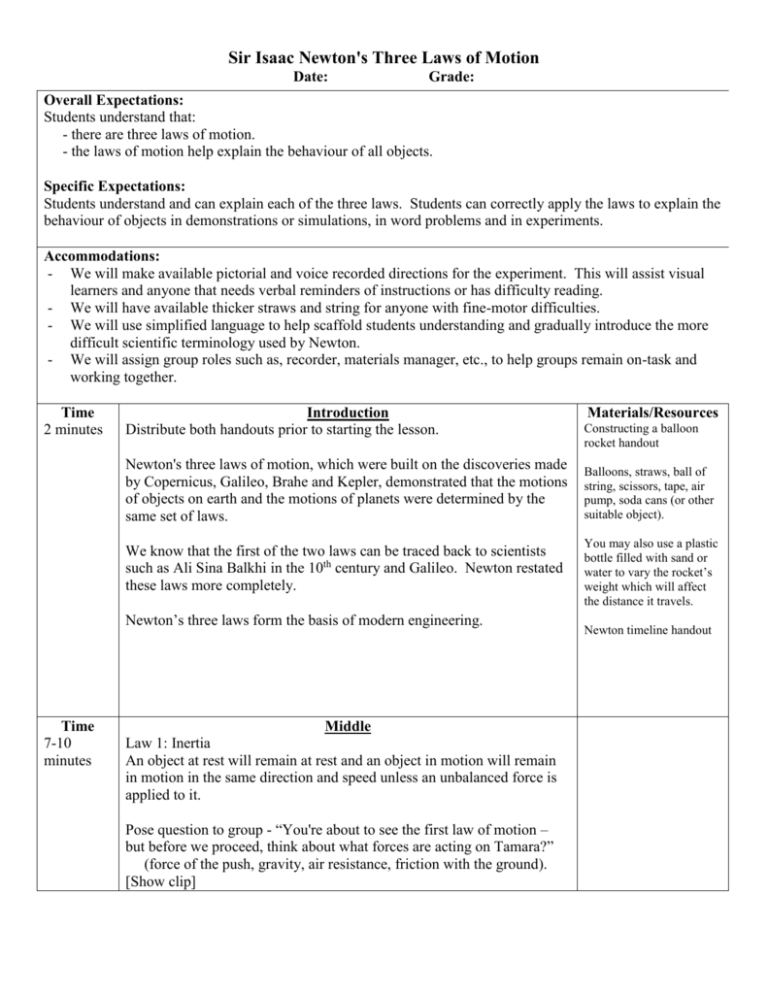
Sir Isaac Newton's Three Laws of Motion Date: Grade: Overall Expectations: Students understand that: - there are three laws of motion. - the laws of motion help explain the behaviour of all objects. Specific Expectations: Students understand and can explain each of the three laws. Students can correctly apply the laws to explain the behaviour of objects in demonstrations or simulations, in word problems and in experiments. Accommodations: - We will make available pictorial and voice recorded directions for the experiment. This will assist visual learners and anyone that needs verbal reminders of instructions or has difficulty reading. - We will have available thicker straws and string for anyone with fine-motor difficulties. - We will use simplified language to help scaffold students understanding and gradually introduce the more difficult scientific terminology used by Newton. - We will assign group roles such as, recorder, materials manager, etc., to help groups remain on-task and working together. Time 2 minutes Introduction Distribute both handouts prior to starting the lesson. Newton's three laws of motion, which were built on the discoveries made by Copernicus, Galileo, Brahe and Kepler, demonstrated that the motions of objects on earth and the motions of planets were determined by the same set of laws. Balloons, straws, ball of string, scissors, tape, air pump, soda cans (or other suitable object). We know that the first of the two laws can be traced back to scientists such as Ali Sina Balkhi in the 10th century and Galileo. Newton restated these laws more completely. You may also use a plastic bottle filled with sand or water to vary the rocket’s weight which will affect the distance it travels. Newton’s three laws form the basis of modern engineering. Time 7-10 minutes Materials/Resources Constructing a balloon rocket handout Middle Law 1: Inertia An object at rest will remain at rest and an object in motion will remain in motion in the same direction and speed unless an unbalanced force is applied to it. Pose question to group - “You're about to see the first law of motion – but before we proceed, think about what forces are acting on Tamara?” (force of the push, gravity, air resistance, friction with the ground). [Show clip] Newton timeline handout Sir Isaac Newton's Three Laws of Motion Date: Grade: Discussion. Law 2: F = ma The acceleration of an object is in proportion to the force applied and is inversely proportion to the mass of the object. Pose question to group – “What could we change to decrease or increase the distance that Tamara moves?” [Show clip] Discussion. Law 3: Every action has an equal and opposite reaction. [Show clip] Follow clip with discussion – “In your groups, think of other examples of action/reaction events.” Discuss these examples as group. Time: 3 minutes Conclusion Demonstrate “Balloon Rocket” experiment (Please refer to “Balloon Rocket Lesson posting in class conference) Pose question for group discussion – “In regards to the experiment we’ve just demonstrated, please explain the motion of the “rocket” using Newton’s three laws of motion?” Discuss adaptations to experiment (ie/ adding with to the container to vary mass, using different balloons, etc.) If there is time, groups carry out balloon rocket experiment. Experiments http://www.at-bristol.org.uk/Newton/experiment.htm#forces Tutorial on force and motion http://www.glenbrook.k12.il.us/gbssci/phys/Class/newtlaws/u2l2a.html http://www.openschool.bc.ca/courses/science/sci8/mod3.html Good for timeline http://www.bbc.co.uk/history/historic_figures/newton_isaac.shtml Official site http://www.newton.ac.uk/newtlife.html Notes/Reminders:
